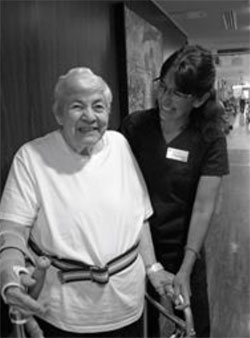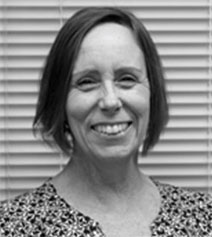Orthopaedic Post Acute: The Post Operative-Pathway to Rehabilitation
By Kimberly Stewart, RN ONC(C)
Consider a petite elderly woman with white, curly hair, kind blue eyes and a face creased with years of life experience. Imagine her quietly resting in a hospital bed after receiving orthopaedic surgery on her left knee, knowing she has to recover in order to function on her own in her one-bedroom apartment. How can she successfully make the transition from hospital to home?
In the Edmonton area, patients undergoing orthopaedic surgery or experiencing bone and muscle impairments can receive additional rehabilitation through CapitalCare's Orthopaedic Post-Acute Programs to regain strength and functionality before returning home. Program criteria provide guidance for determining a patient’s timely transfer as early as their third post-operative day.
 Patients are welcomed into a home-like environment at CapitalCare Grandview – a continuing care centre providing person-centred care for 135 residents who live at the centre year-round, as well as up to 1,000 orthopaedic patients who flow through the Post-Acute Unit’s 45 spaces.
Patients are welcomed into a home-like environment at CapitalCare Grandview – a continuing care centre providing person-centred care for 135 residents who live at the centre year-round, as well as up to 1,000 orthopaedic patients who flow through the Post-Acute Unit’s 45 spaces.
Patients are immediately assessed by a team of nurses, physical and occupational therapists. Recovery plans are developed for each patient based on one of four sub-programs:
1. Elective Arthroplasty Program: The client is pre-assessed at the Edmonton Musculosketal Centre, and undergoes screening, an educational session and an examination for planned surgery. This may be completed for a current total hip replacement, revision of a previous total hip replacement, total knee replacement or revision of a total knee replacement. Length of stay is up to six days.
.2. Fractured Hip Program: The client has experienced a fracture of the femur that is at the trochanter or proximal to the trochanter. Injuries may be treated conservatively or repaired surgically. Hardware used can include Austin Moore (hemiarthroplasty), IM nail or locking IM nail, dynamic hip screw, cannulated screws or a combination of these items. Length of stay is up to 14 days.
3. Orthopaedic Trauma Program: The client experiences a fracture involving the femoral shaft or any other skeletal bones, which may be treated conservatively or surgically. Length of stay is 21 to 28 days.
4. Restorative Care Program: The client possesses an injury that demands a longer recovery phase that cannot be managed at home with homecare. Length of stay is up to 28 days.
A day in the life of an accelerated rehabilitation patient in the Orthopaedic Post-Acute Unit is dedicated to goal-oriented recuperation according to the care pathways developed by Alberta Bone and Joint Health Institute and Alberta Health Services. Patients are encouraged to wash and dress themselves independently, or with minimal aid, and wear everyday clothing. They walk to one of two dining rooms for each meal with gradually reduced assistance, eventually making three round trips per day.
All arthroplasty and fractured hip patients participate in two 45-minute physiotherapy sessions seven days a week; arthroplasty knee patients complete a third set of exercises for flexion and extension. Program reference booklets provide each patient with guidance throughout their recovery period. Whiteboards are also positioned across from each patient’s bed; they display personal information relating to their restoration plan, such as their discharge date, weight-bearing status and appointment dates.
Caregivers further assist patients to become more independent by sharing fall-prevention strategies and post-operative, anti-coagulation self administration in preparation for discharge.
Discharge dates are set on the day of admission and based on the expected length of stay. The projected discharge date is monitored and, in rare instances, adjusted as necessary to coincide with medical, nursing and rehabilitation management, including the completion of discharge criteria. The criteria patients must demonstrate prior to being discharged home include independence with bed mobility, dressing and undressing, standing at the bedside, toilet management and walking with a two-wheeled walker (or with assistance as per their pre-injury environment).
The ultimate goal of the Orthopaedic Post-Acute Program is to enable patients to manage safely at home and help prevent hospital re-admission. Supporting and rehabilitating patients in a homelike environment leaves them feeling more physically conditioned and emotionally confident in their ability to cope at home.
The difference in quality of life is easily recognizable when patients find the appropriate post-operative pathway to rehabilitation with CapitalCare
Attachments
- The Post-Operative Pathway to Rehabilitation
- Fractured Hip Patient Info Signed sheet
- Arthroplasty Patient Info Signed sheet
- ComparisonAdmission Criteria-PostAcute
- Direct Referal Subacute Orthopaedics Final
ABOUT THE AUTHOR

Kimberly Stewart received her Nursing education in Ottawa, Ontario, graduating in 1981. She was hired into Orthopaedics at the University of Alberta Hospital, in Edmonton in the fall of the same year. She quickly fell in love with Orthopaedic Nursing under the mentorship of many skilled Ortho Nurses. Her unit eventually moved to the current Walter C. McKenzie Health Sciences Centre. In the mid-eighties, she became involved in the Canadian Orthopaedic Nurses Assoc., Edmonton Chapter. She is on the Executive of this very busy chapter, hosting education seminar days semi-annually and being involved in many local activities. Kimberly states that achieving her CNA certification in Orthopaedics has been a validating experience for many years in this specialty. In recent years, she has been the Orthopaedic Post Acute Admissions Coordinator at CapitalCare Grandview. Kimberly enjoys spending many hours with her camera, photo- graphing nature. She proudly shares that her greatest pleasure is being the mother to four children (now, young adults).
Comments
-
Lindsay Branderhorst
June 17th, 2024 16:16pmHow is this unit funded? are patient's required to pay for their stay?

